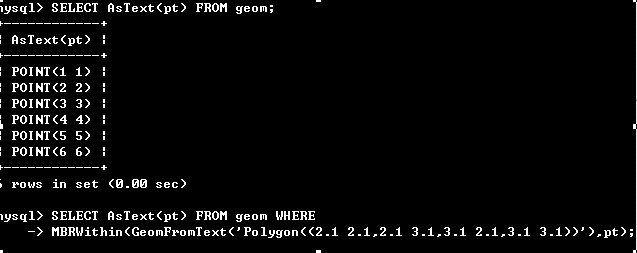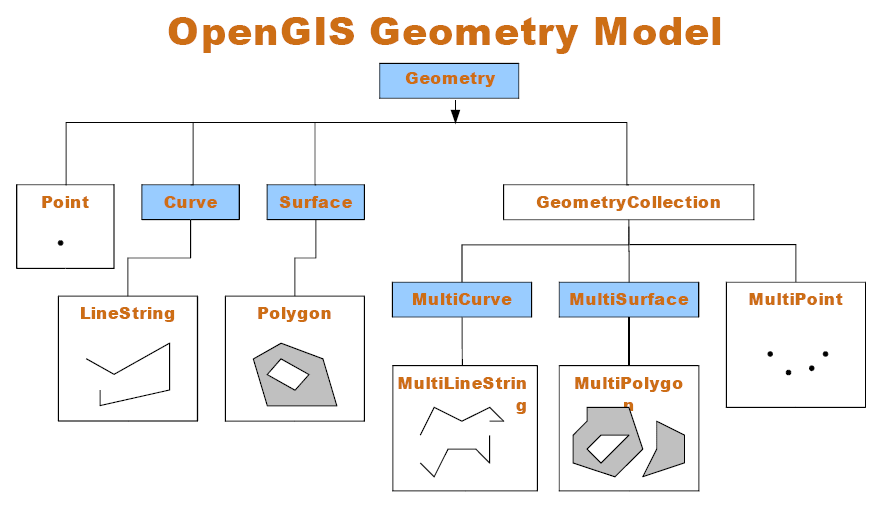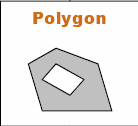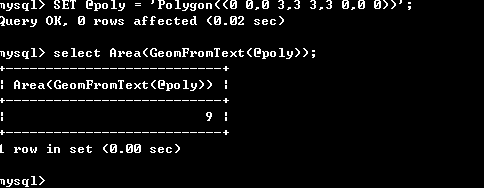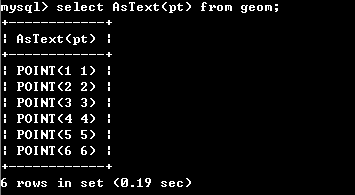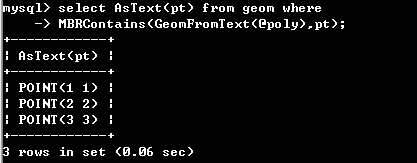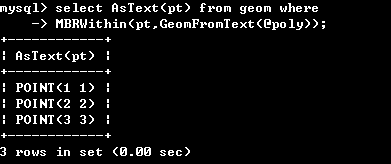06年10月16日
需求:公司现在gis系统有大量的经纬度坐标,都是车辆行驶几个月采集过来的坐标。现在在做区域搜索功能(就是在上个月某个时间内车辆在哪里行驶)。因为现在数据库单个车辆的经纬度坐标太多,所以搜索起来非常慢(让人忍受不了的速度),随着时间的推移,可能搜索起来会越来越慢,所以公司决定考虑使用mysql的空间数据库特性。把经纬度坐标都转移到成空间数据库坐标.
公司使用mysql4.1.2,
说明:这是本人学习mysql的空间数据库特性时候解决的一些问题和和对一些问题的看法,肯定有错误的地方,希望看到这篇文章的朋友能够多多指教,给我留言。
大致需要解决的问题如下: 1 空间数据库怎么样存储经纬度坐标? 2 现有的经纬度坐标如何转换成空间数据库的经纬度坐标? 3 如何查询空间数据库里面的数据? 先来解决第一个问题! This section describes the standard spatial data formats that are used to represent geometry objects in queries. They are:
Internally, MySQL stores geometry values in a format that is not identical to either WKT or WKB format. (通常用来表示几何物体的空间数据格式有2种一种是WTK格式,一种是WKB格式。)
WTK格式存储几何物体的一些例子 Examples of WKT representations of geometry objects:
· POINT(15 20) Note that point coordinates are specified with no separating comma.
· LINESTRING(0 0, 10 10, 20 25, 50 60) Note that point coordinate pairs are separated by commas.
· POLYGON((0 0,10 0,10 10,0 10,0 0),(5 5,7 5,7 7,5 7, 5 5))
· MULTIPOINT(0 0, 20 20, 60 60)
· MULTILINESTRING((10 10, 20 20), (15 15, 30 15))
· MULTIPOLYGON(((0 0,10 0,10 10,0 10,0 0)),((5 5,7 5,7 7,5 7, 5 5)))
· GEOMETRYCOLLECTION(POINT(10 10), POINT(30 30), LINESTRING(15 15, 20 20))
WKB格式存储的一些例子 The Well-Known Binary (WKB) representation for geometric values is defined by the OpenGIS specification. It is also defined in the ISO SQL/MM Part 3: Spatial standard. WKB is used to exchange geometry data as binary streams represented by BLOB values containing geometric WKB information. WKB uses one-byte unsigned integers, four-byte unsigned integers, and eight-byte double-precision numbers (IEEE 754 format). A byte is eight bits. For example, a WKB value that corresponds to POINT(1 1) consists of this sequence of 21 bytes (each represented here by two hex digits): 0101000000000000000000F03F000000000000F03F The sequence may be broken down into these components: Byte order : 01 WKB type : 01000000 X : 000000000000F03F Y : 000000000000F03F Component representation is as follows:
WKB values for more complex geometry values are represented by more complex data structures, as detailed in the OpenGIS specification.
MySQL Spatial Data Types (mysql的空间数据格式) MySQL has data types that correspond to OpenGIS classes. Some of these types hold single geometry values:
GEOMETRY can store geometry values of any type. The other single-value types (POINT, LINESTRING, and POLYGON) restrict their values to a particular geometry type. The other data types hold collections of values:
GEOMETRYCOLLECTION can store a collection of objects of any type. The other collection types (MULTIPOINT, MULTILINESTRING, MULTIPOLYGON, and GEOMETRYCOLLECTION) restrict collection members to those having a particular geometry type.
现在两种空间数据的存储格式大致已经知道了,mysql的空间数据类型也清楚了。 现在猜想第二个问题解决的大致过程是! 15,20 转换成 标准空间格式(wtk) poing(15,20) 然后再用mysql函数转换到 mysql的空间数据列中。 现在实现看看 1 先在test数据库里添加一个支持空间数据列的表geom. CREATE TABLE geom (g GEOMETRY); 但这里出现一个问题:The storage engine for the table doesn’t support GEOMETRY 大致意思:就是这个表的存储引擎不支持GEOMETRY列,查了下文档,‘spatial columns are supported only for
2 在geom表里添加可以存储point类型数据 ALTER TABLE geom ADD pt POINT;
3 向point列添加标准的空间数据
4 数据已经存进去了,只要把它去出来,第三个问题也就解决啦!
这是从mysql的空间数据列中取出标准的wtk格式空间数据的函数AsText().
存储读取三个问题解决了!接下来自由发挥了! |
06年10月18日 4 如何判断已有的经纬度点在某一区域内? 在mysal4.1官方的文档找到下列函数,应该就是解决问题4的
现在我需要的功能是查找一辆车在某一段时间内是否在一段区域内经过,用点来说明的话,就是一个空间坐标点在一个特定时间段内是否包含在一个特定的矩形区域内。下面这个函数应该能达到这个功能:
Returns 1 or 0 to indicate whether the Minimum Bounding Rectangle of g1 is within the Minimum Bounding Rectangle of g2.
下面是文档中解决问题4的方法。
在geom有6个点,现在构造一个Polygon((2.1 2.1,2.1 3.1,2.1 3.1,3.1 3.1)),判断是否有点包含在Polygon里,下面是实现过程。 按照判断应该有Point(3 3)应该包含在Polygon内。但是实际情况确实空集。出什么问题了呢?见下图。
查看Polygon的定义,查找原因。 YES!Polygon的外部边界(即第一参数)应该是封闭的。而我在上面构造的矩形只是我莫须有想出来的,不符合Polygon的规范 下面再实验下。
06年10月18日(晚)
|






